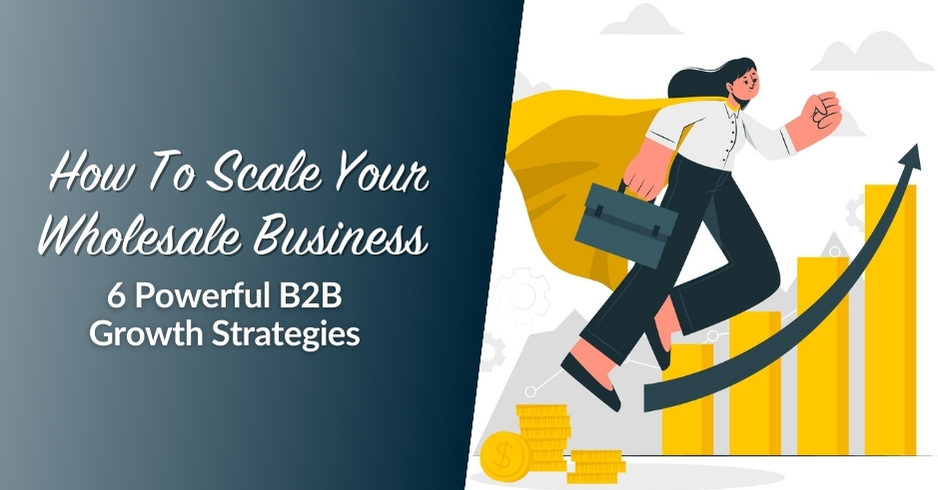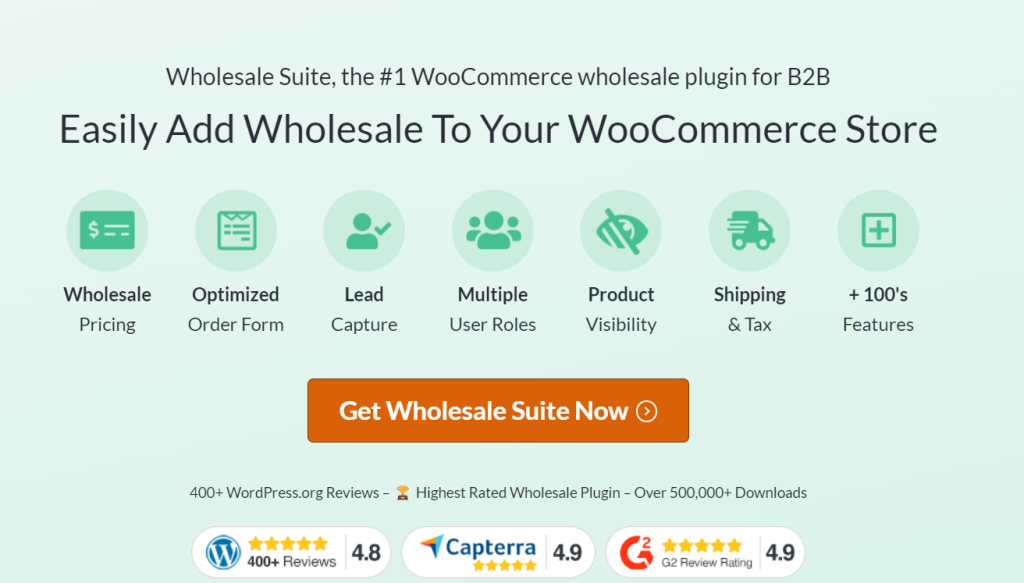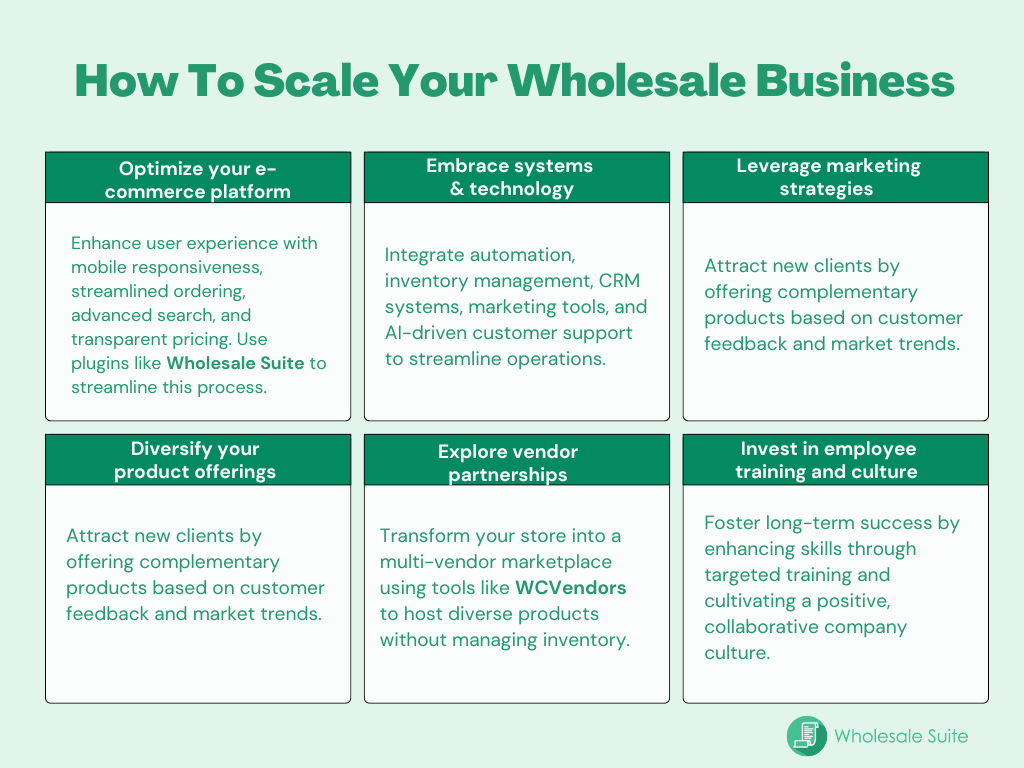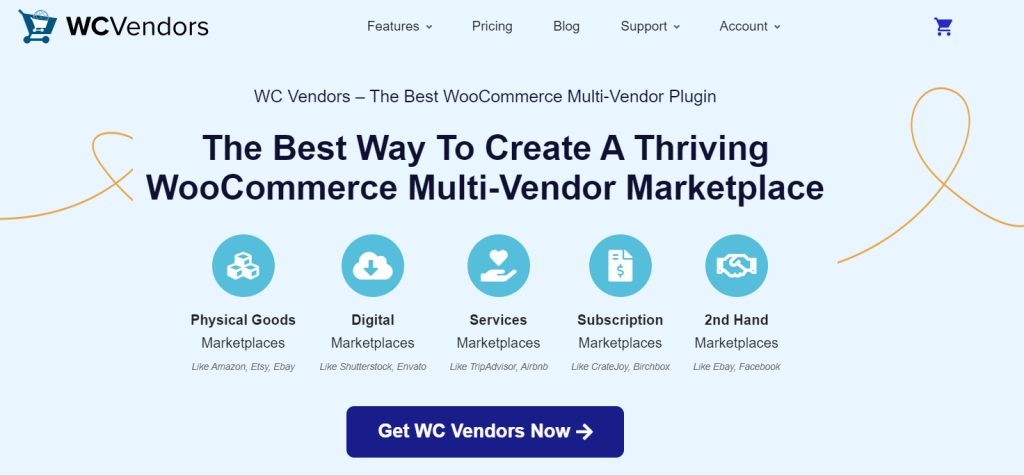
The beginning of a new year is always an exciting time for businesses. It’s the perfect opportunity to set new goals to move your business forward. If you’ve been feeling like your wholesale venture has plateaued, we’re here to usher in the new year spirit with actionable B2B growth strategies!
We get how challenging it can be to grow and sustain a thriving wholesale business. However, stagnation is not an option in today’s competitive landscape. The failure to grow and adapt can leave your business trailing behind.
Without further ado, let’s reveal key B2B growth strategies you can begin doing today to expand your business this year!
6 B2B Growth Strategies To Expand Your Wholesale Business
Below, we’ve enumerated key B2B growth strategies to help you stay ahead of the curve and grow your business this year.
1. Optimize your e-commerce platform
Growing your business means meeting your potential clients where they’re at. The customer buying journey in the B2B landscape has shifted dramatically over the years. According to industry insights, 72% of B2B buyers start their sales journey online.
To grow your business, it is important to optimize your e-commerce platform to create the best user experience. Firstly, you’ll need to conduct a comprehensive audit of your website. Take advantage of any past feedback you’ve gathered from your B2B customers to identify any bottlenecks in your current system.
To provide the best customer experience to your B2B clients, consider the following key metrics:
- Mobile responsiveness: A significant portion of customers browse on their mobile devices, so ensure seamless navigation across different screen sizes.
- Streamlined ordering: Make bulk ordering a breeze for your wholesale customers. Consider implementing a tailored ordering form or system they can use to place orders effortlessly.
- Advanced search and filtering: This is crucial, especially if you have a wide selection of products for sale. Make product search and selection as easy as possible by giving your B2B clients the option to search via product name, SKU, category, and more.
- Transparent pricing: Your B2B customers are always on the lookout for the best deals, as their purchases are significant. Therefore, it’s crucial to display wholesale prices and bulk discounts prominently on your e-commerce website. Leverage visuals such as crossed-out retail prices, wholesale discount tables, savings breakdowns, and more.
Wholesale Suite

To take your e-commerce optimization to the next level and implement improvements easily, consider taking advantage of tools like Wholesale Suite. This all in one solution is crafted for WooCommerce wholesalers, allowing you to manage all aspects of your wholesale operations seamlessly.
- Wholesale Prices Premium allows you to manage wholesale pricing, set wholesale discounts, implement tiered pricing strategies, and tweak product visibility for B2B buyers.
- With Wholesale Order Form, you can create tailored, one-paged ordering forms that streamline the bulk purchase process. It showcases your entire wholesale product selection seamlessly and allows you to implement filtering capabilities to improve the buying experience.
- Wholesale Lead Capture makes lead capturing and onboarding easier with user-friendly registration forms. It gives you full control over your wholesale ecosystem, allowing you to manage users and give them a unique role to access your B2B deals and offerings.
- With Wholesale Payments, you can offer flexible payment terms to wholesale customers, create custom payment plans, and streamline invoicing.
2. Embrace in systems and technology
As a thriving wholesale entrepreneur, we already know you’re amazing at juggling multiple aspects of your business. However, if you want to maximize the potential of your venture, it’s crucial to outsource some of your processes to systems and technologies. Embracing automation can help you focus more on your core drivers of growth, such as product development or customer relationship management.
When it comes to B2B growth strategies, weaving technology seamlessly into your operations is a game-changer. To begin, evaluate each aspect of your business and identify which parts of your operations can benefit from time-saving technologies.
For example, you might consider implementing:
- Inventory management systems: Inventory management technologies allow you to stay updated with stock levels through real-time tracking and monitoring. As a result, you reduce the risks of understocks or overstocks.
- Customer relationship management (CRM) systems: CRM tools provide key insights into customer behaviors and preferences, allowing you to tailor the customer experience.
- Marketing automation tools: You can also consider implementing marketing automation tools to streamline your marketing efforts, keep customers engaged, and build loyalty.
- Artificial Intelligence for Customer Support: AI-driven customer support technologies (such as chatbots) can help you provide quick assistance to B2B customers to enhance customer satisfaction.
Aside from increasing the efficiency of your operations, these technologies lay the groundwork necessary for scalable growth.
3. Leverage marketing strategies to increase brand awareness
If you truly want to scale your business, then it’s important to reach as many potential customers as possible. Marketing allows you to expand your reach, making it one of the most important B2B growth strategies to focus on.

However, there is no one-size-fits-all approach to marketing. Experimenting strategically with different marketing channels will help you find out which works well for your business. So, don’t be afraid to think outside the box and try out new platforms. Consider:
- Strengthening your content marketing efforts: As a wholesale business, you are most likely catering to fellow business owners in search of valuable solutions. You can fortify your position as an industry leader by crafting insightful blogs, articles, and guides that address the pain points of your audience.
- Using email marketing strategically: Email marketing is one of the most powerful marketing tools you can use to engage with both new and existing B2B customers. Strategically sending out emails can help you move hot leads further into their sales journey.
- Attending relevant B2B industry events: These events provide you with opportunities to network and showcase your business to potential customers and partners. It also gives you a closer look at your competitors.
- Optimizing your website for search engines: Conduct keyword research to understand which terms your customers are searching for. Then, implement these keywords into your content, product descriptions, and meta tags to enhance your online visibility in search results. This can help your B2B clients find you as they’re seeking solutions.
4. Diversify your product offerings
One of the most powerful B2B growth strategies is diversifying your offerings. This move can help you attract new clients and increase the satisfaction of your existing customers.
Firstly, begin your market research by asking your current customers what other solutions they want your business to offer. Additionally, make sure to keep an eye out for emerging trends within your niche. These valuable insights can give you an idea of what offerings will resonate with your market’s demands.
However, you’ll want to be careful to not stray too far from your core business offerings. Instead, adopt a strategic approach. Analyze your current product lineup and identify opportunities for expansion that blend with your existing products.
For instance, if you’re a wholesaler of office supplies, you can consider expanding into related categories such as ergonomic furniture or advanced technology accessories. This ensures that you stay true to your brand’s image while catering to the evolving needs of your clients.
5. Expand your offerings through vendor partnerships
If adding new products to your core offerings is not feasible yet, then this next B2B growth strategy can be another powerful option for you.
You can easily expand your offerings and reach more customers by partnering with vendors and transforming your e-commerce store into a multi-vendor marketplace. This allows you to host multiple vendors on your platform, allowing them to sell their products without the need for you to manage the inventory for these items.
The best part? This process doesn’t have to be a daunting task with the right tools at your fingertips. WooCommerce store owners, for instance, can leverage plugins like WCVendors to easily transform their e-commerce platform into a thriving multi-vendor marketplace.
This powerful plugin allows store owners to:
- Onboard vendors effortlessly: This powerful plugin streamlines the vendor onboarding process, allowing vendors to register and start listing their products with ease. They also gain access to user-friendly dashboards where they can manage their products and monitor the performance of their stores.
- Manage all aspects of the vendor: As the marketplace owner, you can customize your platform with WCVendors’ built-in settings system and configure the vendor dashboard requirements to suit your business needs.
- Set an advanced commission system: WCVendors features an advanced commission system that allows you to set commission rates globally, per vendor, or per product, so you can reward your vendors effortlessly.
- Build trust with transparency: Leverage the power of social proof with the WCVendors ratings system. This allows customers to rate vendors upon purchase, helping vendors build brand value and fostering transparency in your marketplace.
6. Invest in employee training and culture
As a wholesale business owner, it’s also important to recognize the pivotal role that your team plays in the success of your ventures. By investing in employee training and creating a positive company culture, you lay the foundation for long-term success.

Start by identifying key competencies that align with your business goals for the year. For example, if you plan to increase your marketing efforts to strengthen your brand image, you can consider investing in training programs covering SEO, digital content creation, and social media strategies.
Depending on your objectives, this may also entail expanding your team by hiring individuals with specialized skills that can help you expand your business.
Additionally, it’s important to cultivate a positive company culture. Celebrate milestones and create an environment that fosters collaboration and innovation. Encourage your team members to share ideas and contribute suggestions to improve your current systems and processes.
Conclusion
Your wholesale business can’t afford to be left behind. In this guide, we’ve covered key B2B growth strategies that can help you expand your business and stay ahead of the curve this coming year. To summarize, let’s recap them below:
- Optimize your e-commerce platforms
- Embrace new systems and technologies
- Leverage marketing strategies to strengthen your brand
- Diversify your product offerings
- Expand your offerings through vendor partnerships
- Invest in employee training and culture
Tools like Wholesale Suite can help you achieve your expansion goals this coming year. This all-in-one solution allows you to streamline your wholesale operations on your WooCommerce store. It features four powerful plugins that enable you to manage wholesale pricing, create one-paged ordering forms to simplify the purchase process, capture B2B leads effortlessly, and offer flexible payment terms.
So, which of these B2B growth strategies are you most excited to explore this year? Let us know in the comments section below!






